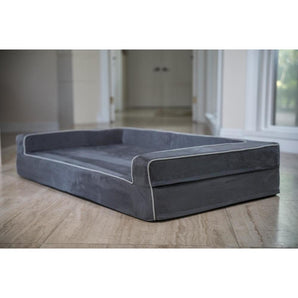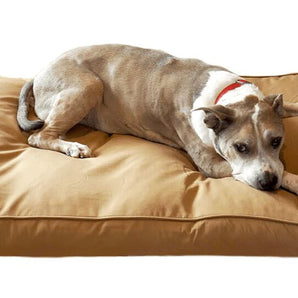Arthritis in dogs is more common than many pet owners realize, especially for big pups. Those long legs and heavy bodies may look majestic, but they put a lot of stress on the dog's joints over the years. If your large or senior dog is moving slower than usual, it's worth learning the signs of arthritis and how to help them stay comfortable. The sooner you catch it, the better you can manage it.
What is Canine Arthritis?

Canine arthritis is a chronic, painful condition caused by inflammation in the joints. Just like in humans, it tends to develop gradually, making it easy to miss in the early stages. The most common form is osteoarthritis, also known as degenerative joint disease (DJD), where the cartilage that cushions your dog’s joints starts to break down over time. This leads to pain, stiffness, swelling, and a reduced range of motion in the affected joints.
While arthritis can affect dogs of all sizes, large and giant breeds are especially prone due to the extra weight and pressure on their joints. Older dogs are also more at risk, though even younger dogs can develop arthritis due to injury, genetics, or underlying conditions like hip dysplasia or elbow dysplasia.
Early Signs of Arthritis in Dogs
Arthritis doesn’t just show up one day out of nowhere—it often starts with subtle changes in your dog’s movement or behavior. Keep an eye out for these tell-tale signs your dog may have a degenerative disease affecting their joints:
1. Difficulty Getting Up Or Lying Down
If your dog struggles to stand up after resting or seems hesitant to lie down, that’s a big red flag. Dogs with arthritis may take a few extra seconds to get their back legs under them, or they might brace themselves with their front legs first. You might also notice them circling more than usual before lying down, trying to find a comfortable position.
These movements that once seemed effortless now require more effort and sometimes even cause significant pain. Over time, your dog's hesitation may become more pronounced, especially in cold or damp weather when joint stiffness tends to be worse.
2. Reluctance to Climb Stairs or Jump
If your once bouncy pup now avoids the stairs, hesitates before hopping into the car, or skips their favorite chair or couch, arthritic joints could be the reason. Climbing or jumping puts added pressure on the hips, knees, and spine—all common spots for arthritic flare-ups.
Many large dog owners notice this sign first. It’s especially common in breeds like German Shepherds, Labs, and Great Danes, who are already predisposed to joint issues. Keep in mind, your dog might not cry out in pain—but their reluctance to move a certain way is often their way of telling you something hurts.
3. Limping or Lameness
Limping is one of the more obvious signs of joint pain. You might notice your dog favoring one leg, walking stiffly, or avoiding putting weight on a certain paw. The limp may come and go, especially after exercise or naps.
Chronic limping usually indicates inflammation (swollen joints) or damage in the joints. And while a limp might seem minor at first, it can progress quickly if the arthritis isn’t addressed. If your dog’s gait has changed, it’s time to check in with your vet.
4. Less Interest in Walks or Play
We all love those excited tail wags when the leash comes out. But if your dog seems less enthusiastic about walks or stops wanting to play fetch, arthritis may be the culprit. Dogs in pain naturally avoid activities that make them uncomfortable.
You might notice your dog tiring more easily, walking slower, or laying down halfway through their usual walk. Playtime might shrink from 10 minutes to just a few. While it’s tempting to chalk it up to aging, don’t ignore these behavioral shifts—they could be signs of discomfort.
5. Behavioral Changes
Pain doesn’t just affect movement—it can also impact your dog’s mood. A normally sweet dog might start growling or snapping when touched, especially near painful joints. Others may become withdrawn, clingy, or anxious.
Changes in appetite, disrupted sleep, or increased vocalizations (like whining or barking) can also point to arthritis in dogs. Dogs can’t tell us what’s wrong with words, but their behavior speaks volumes when something’s off.
6. Muscle Loss
Dogs with arthritis often stop using certain muscles because it hurts to move. Over time, they may develop muscle atrophy, especially in the hind legs. You might notice that your dog’s hind legs look thinner or weaker than they used to.
Muscle loss not only makes arthritis worse (there's less support for the joints) but can also affect your dog’s balance and coordination. This is why keeping your pup moving—gently—is so important.
7. Licking or Chewing at Joints
Many dogs instinctively lick painful areas in an attempt to soothe them. If your pup constantly licks, chews, or bites at a particular joint (like the wrist, elbow, knee, or hip), it could be arthritis-related. Sometimes the skin in those areas becomes irritated or stained from all the licking.
It’s easy to mistake this for allergies or boredom, but repeated attention to one joint often signals discomfort. If you see this along with any of the other symptoms above, it’s time for a vet visit.
Tips for Managing Your Dog's Arthritis

While there’s no cure for arthritis (although there is emerging research that stem cell therapy may have health and medical benefits for arthritis management in dogs), there’s a lot you can do to keep your dog comfortable and improve their quality of life. A combination of lifestyle changes, veterinary care, and at-home adjustments can make a world of difference.
Choose An Appropriate Bed For Your Older Dog
A supportive, non-chewable orthopedic dog bed is a must when it comes to managing arthritis in dogs. Hard surfaces or thin bedding can put extra pressure on the affected joints, making pain and stiffness worse. Look for a bed made with high-density or memory foam that cushions and conforms to your dog’s body.
For large dogs especially, the right bed can make getting up and lying down so much easier. Bully Beds are designed with big dogs in mind—they’re orthopedic, supportive, and easy to clean (which is great if your pup is dealing with incontinence too). A good bed won’t cure arthritis, but it can provide comfort and pain relief.
Consider Joint Supplements
Joint supplements can support cartilage health, reduce inflammation, and ease arthritis symptoms over time. Look for ingredients like glucosamine, chondroitin, MSM, omega-3 fatty acids, and turmeric.
While supplements don’t work overnight, many owners report real improvements with consistent use. Talk to your vet about what’s appropriate for your dog’s age, weight, and health history.
Manage Your Dog's Weight
Extra weight puts extra strain on already painful joints. Even a few extra pounds can worsen your dog's symptoms, especially for big dogs. Keeping your pup at a healthy weight is one of the best things you can do to ease their discomfort.
Talk to your vet about a weight management plan if needed. Switching to a lower-calorie dog food, feeding measured portions, and skipping the extra treats can go a long way toward helping your dog feel better.
Keep Your Dog Active to Prevent Muscle Atrophy
Movement is medicine when it comes to arthritis—just make sure it’s gentle. Daily walks, short play sessions, and low-impact activities like swimming can help keep your dog’s muscles strong and joints mobile.
Avoid high-impact games like fetch or roughhousing, which can worsen arthritis in dogs. Instead, focus on regular, low-stress movement to prevent stiffness and slow down muscle loss.
Keep Up With Regular Vet Appointments
When it comes to managing arthritis in your dog, regular vet checkups are one of your most important tools. A thorough physical examination can reveal subtle changes in your dog’s mobility, behavior, or weight that you might not notice at home. Your vet can assess the progression of the disease and adjust your dog’s arthritis treatment plan as needed.
For dogs with severe arthritis, these visits are especially important. As the condition worsens, your dog may need stronger pain management strategies to maintain quality of life. That could include pain medications, laser therapy, acupuncture, or even physical therapy tailored specifically for arthritis in dogs.
If you’ve noticed signs of stiffness, reluctance to move, or changes in your dog’s pain levels, don’t wait until the next annual appointment—call your vet and get them seen sooner. Early intervention and consistent care can help slow the progression of arthritis and keep your pup more comfortable for the long haul.
The Best Orthopedic Bed for Arthritic Dogs

When it comes to managing arthritis, one of the easiest upgrades you can make is your dog’s bed. Bully Beds are designed for big dogs and aging joints. Each bed is made with thick orthopedic memory foam that supports pressure points, cradles sore joints, and helps your dog rest more comfortably.
Plus, the washable covers and waterproof liners make cleanup easy if your senior pup has an accident. With multiple sizes and firmness levels to choose from, you can find the perfect fit for your dog’s needs—and make every nap a little more restorative.





